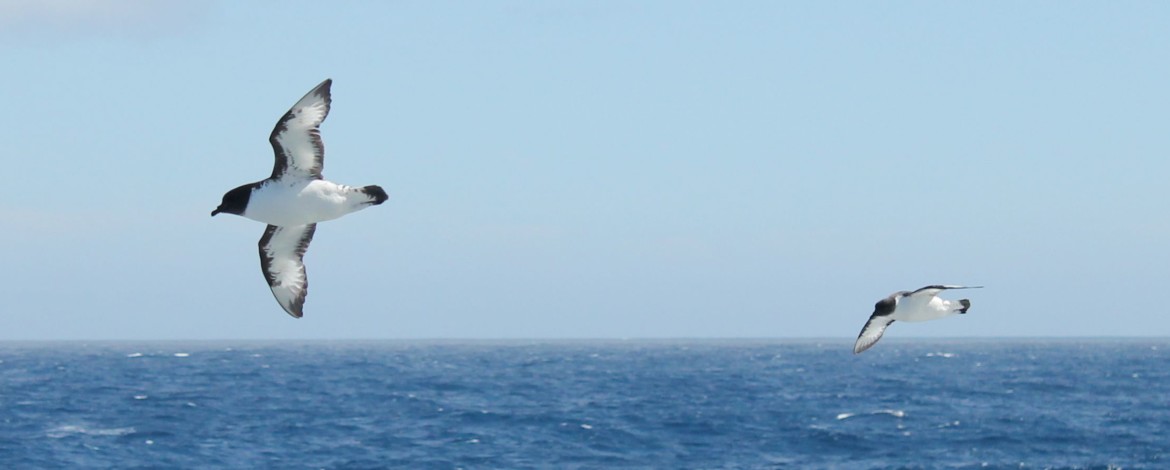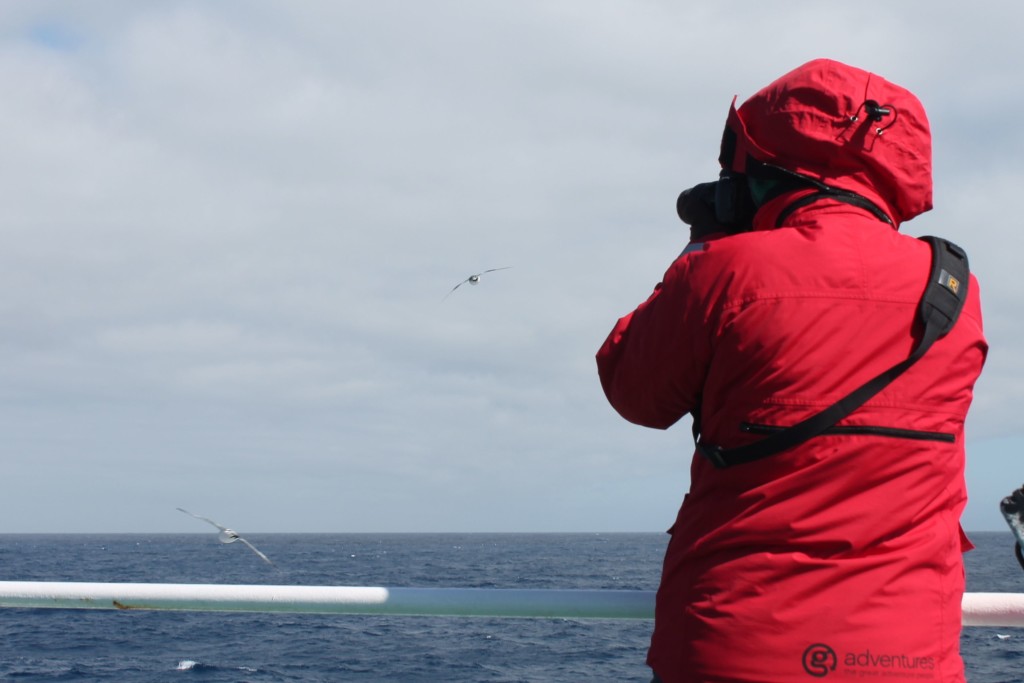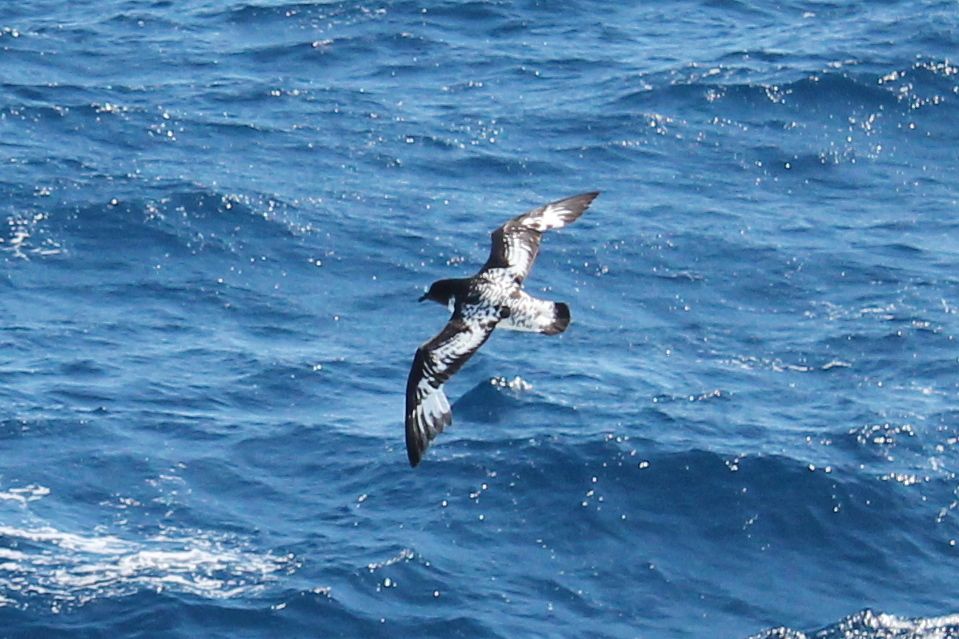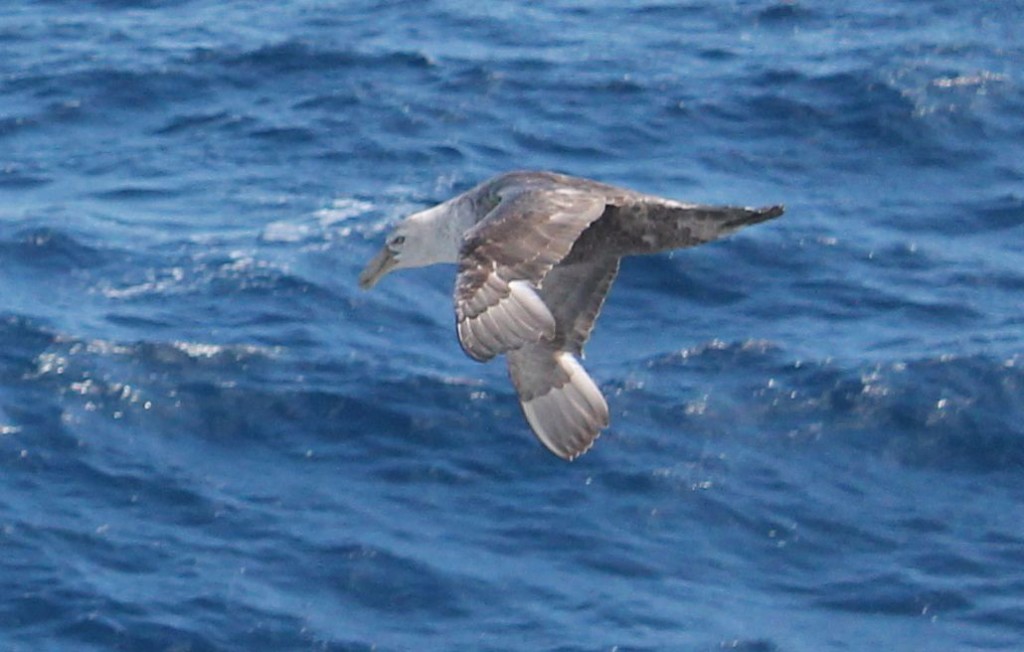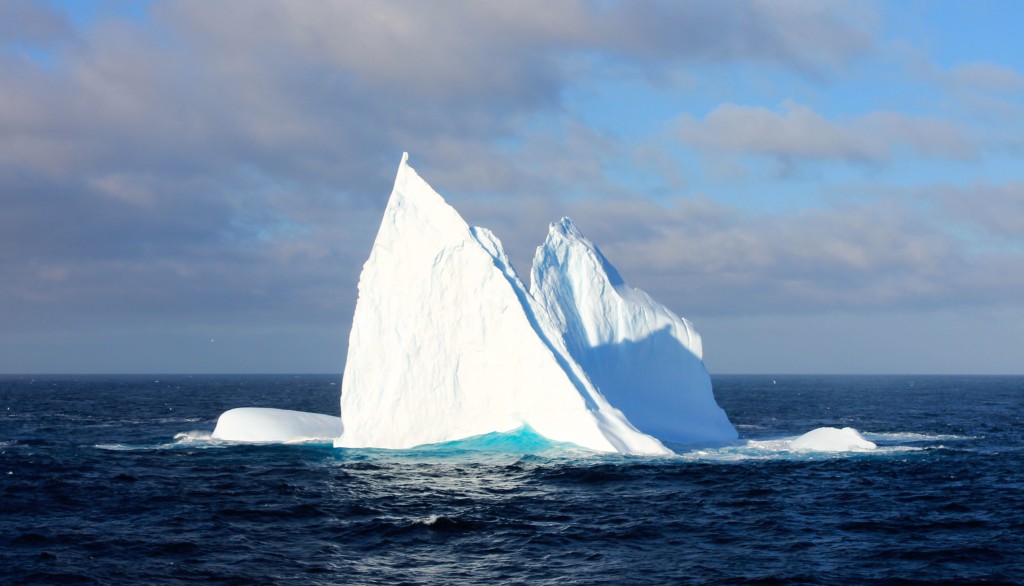Thankfully, sunset on the second night was as benign as the first. By the end of the day the worst of the stormy conditions had passed, and while the boat still rocked, the skies were clear. I stood out on deck with a fast cooling coffee to watch the last of its light. A flock of 6 or 7 cape petrels were trailing the ship. Occasionally they’d swoop up close around the deck. Perfect for someone like me who is severely outgunned in the zoom capabilities of their camera lens. But as I said then, it’s not the size of the lens that matters to a man, it’s how you use it. There were also a couple of larger southern giant petrels, and one black-browned albatross. The albatross hung back. Alone, self assured, impervious to photography. While I’ve never been bird watching before there is a certain serenity in identifying the various birds that trail in the wake. One of the on board biologists would also later tell me how well these albatrosses are perfectly adapted to the environment. The longest wing span of any bird, the wings lock outstretched allowing it to glide without expanding energy. Unique amongst bird species, they also have an acute sense of smell. Two long tubes along the side of the bill act as nostrils. Something to aid the search for prey in this vast environment. And while, the petrels occasionally landed on the surface of the water, the albatross would rarely do this. They’re capable of staying air for perhaps days at the time. Up to 10,000 miles without rest. At these latitudes that’s nearly the circumference of the Earth. Some even assume that the albatrosses can sleep while in the air – talk about effortless!
I was still waiting to get a definite sighting of the famed wandering albatross. It has the largest wing span of all birds, and from Samual Colerdige’s rhyme of the ancient mariner on is a literary legend. It’s sailors superstition that it’s a good omen to have one of these trailing the ship. It’s only turns to a curse if you kill one – as did a mariner with a crowsbow in Coleridge’s poem. Lucky for us, the passengers on this ship were more proficient shooting with a camera than with medieval weapons. And luckier still, these wandering birds were somewhere in company. The Spaniard was a keen birdwatcher, and as we crossed paths later that day I asked if he’d seen one. “I did”, he told me. “And I cried. It’s always been a dream of mine to see one of these birds out in the wild. And now I’ve seen one”. For some, this trip really was a way of making a dream come true. My ambitions were perhaps less poetic in nature. Before embarking I’d joked that I’d so far I’d had drunken occasions on every continent I’d be too. It wouldn’t be enough to simply step on Antarctica, I’d also need to utilise the wine and rum that I’d brought along!
Things were relaxed as we continued across the rest of the drake passage towards land. With the aid of some preventative medication I remained relatively free from seasickness, and others gradually joined me in the lounge as the third day began. I listed to more lectures and watched more birds from deck with cups of steamy hot drinks. I was relaxed in the knowledge that I’d be called for meal times, and would remain well fed. There is a serenity in it all. Being away from the internet and all forms of communication. Having your day planned out, and sparsely so. I’m considering implementing internet, phone, and media free Sundays when I return to working life in London. Space to switch off and think freely about other things. I read more too.
In a recent book called Empire Antarctic a young doctor talks about his year on the most isolated of continents. After medical school, Gavin Francis craved an escape. Away from the pressure of imminent career choices, and the professional and social stimuli that surrounds and attacks us day after a day. To a place that had fascinated ever since an atlas was first held and studied as a child. Somewhere that would final offer the place to reflect and think. He was posted to Halley, the deepest and most isolated of Britain’s modern day research stations. Only an assortment of 16 remain resident here over the winter period. Scientists, engineers, a cook, and a doctor. When the days begin to grow shorter, the link to the outside world begins to dissipate. First the larger summer crew depart, and soon after the sun will spend a few days circling low on the horizon, shedding pastels of reds and oranges across the sky. It’s the most prolonged sunset you can ever expect to see, before it lingers no more, and descends completely. For more than 100 days of perpetual darkness the only link from home is a faint crackle picked up from the BBC World Service. There is no escape until the light returns. The base becomes surrounded by hundreds of miles of sea ice, and flying conditions in the harsh winter winds are impossible. But darkness is a loose term. When the clouds lift the aurora australis (the southern lights) streak across the sky impossibly vibrantly, against a backdrop of a million stars. Few humans get to see that. There was a time only two centuries ago when reaching so far south seemed as daunting as a trip to Mars does today. For Gavin Francis this beauty in the grand expanse of isolation was something quite truly life enriching, and cause to write an excellent book.
We were still far from these southern latitudes. So much so, we’d not yet seen much ice. There was a competition on board to guess the time we’d spot the first iceberg bigger than the size of the ship. In came sooner than I imagined, when we were still 4 hours from the first land of the South Shetland islands. (These islands sit less than 100 miles from the continental peninsula, and were first claimed by Britain in the early 1900s. Today they’re also claimed by Argentina and Chile, and scientific bases from all three countries pepper the islands.) We were 50 miles from them, and they sat far beyond the clean horizon where the sky meets the sea. The ice berg was first nothing more than a glint over the cresting waves, we approached steadily in the bright sunlight. Penguins hunting far from shore, and the distant jets from whale blow holes our company. The ship deviated course to give us a better view. An automatic warning siren whining from the bridge when we were close, a titanic collision possible for the careless. The berg was almost solid white. The colour likely signals that it’s relatively new ice, that has not yet undergone years of compression. As a rough rule of thumb older ice will seem to glow blue, from the refraction of the light that passes through it. And if ice is truly old enough light passes completely through. These blocks of black ice are denser and sit lower in the water, a danger for ships due to the greater challenges of detection. They are nicknamed growlers. If you put a chunk into your drink it crackles – or growls. They have no air bubbles, and so there are small explosions as the air finds other means to escape. A glass of whisky with added attitude.
Regardless of the age of this ice berg, waves broke impressively against it. People concurred that it was beautiful, with Petrels and southern fulmar sea birds circling and feeding nearby. But it also had the look of a decaying tooth about it, upside down and cavity ridden. Large tabular ice bergs – those that break of from glacier shelves – can last for about 2 years while floating in the oceans. But this one, so far from shore, and with no cover from the elements, it would soon decay completely.
There was a bottle of wine for the winner at dinner, and naturally I made sure to sit on their table. It took some time to get uncorked. After all, this was a holiday – everyone wanted a drink with dinner. The waitress rushed overworked from table to table. The diving Australian was with us too. She enjoyed story telling. From recent years lecturing in China to diving down to ship wrecks in the tropics. But most memorably she told us a story about her husband. He used to work calculating the flight paths for satellite launches. Putting together the mathematics that ensures a satellite breaks free of the Earth’s gravity, and orbits precisely where it should. Only not every launch goes successful. This one was being launched from Finland. And rather than reaching its predetermined point in an orbit 10,000km above the Earth, this one crashed back down to the surface. Across the border. Into Russia. It created a minor diplomatic incident – the Russians threw out accusations of war provocation, and promptly confiscated the warped and battered satellite. While I might make the odd mistake at work, it’s generally lost within a tide of emails. Nothing quite so public. It took some heavy cross border discussions to smooth things over. Eventually, in a big show of no hard feelings the Russian army marched the satellite back to the border. When it was taken back it was discovered that it was emptied of all electronics and innards. And with a hint of making good use of what lands in your own back yard – some months later the Russians launched their own satellite. At least, it turned out the husband wasn’t to blame. There had been a launch malfunction nothing to do with his calculations. I’m glad, from years of quantitative exams I have a soft spot for professional mathematicians. But, since I’ve got back to the UK, I haven’t been able to verify if this is all true. Yet how much does it matter if it’s a good story?
We passed between the islands later that day, after sunset. The passage was wide, and the two snow covered masses of land seemed distant through the fog, fading in the growing absence of light. We were to wake up early. To walk the land we’d been approaching.
